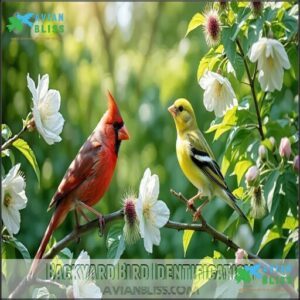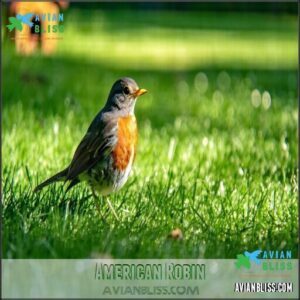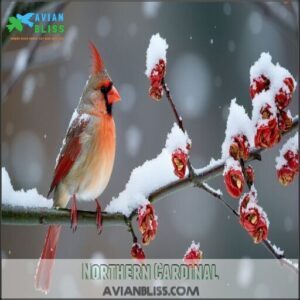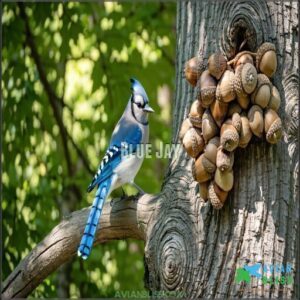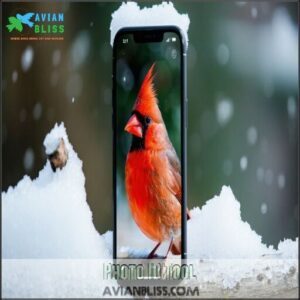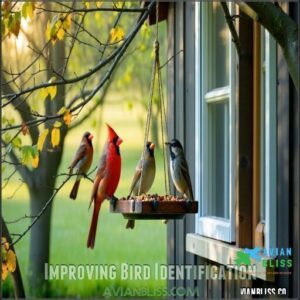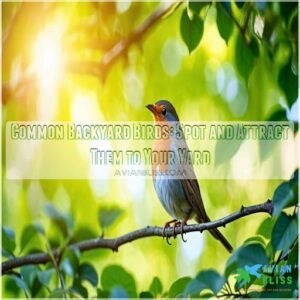This site is supported by our readers. We may earn a commission, at no cost to you, if you purchase through links.

Pay attention to the beak—it’s a clue to what they eat. Behavior matters, too; watch how they move or interact.
Use tools like the Merlin Bird ID app or a good field guide for quick matches. Listening helps, too—bird songs can be as distinct as fingerprints.
Spotting a red Northern Cardinal or a cheerful American Robin can feel like uncovering a secret. Keep watching—seasonal visitors can surprise you!
With patience, your backyard becomes an open-air avian encyclopedia.
Table Of Contents
- Key Takeaways
- Backyard Bird Identification
- Common Backyard Birds
- Bird Identification Tools
- Regional Bird Variations
- Improving Bird Identification
- Frequently Asked Questions (FAQs)
- How do I identify backyard birds?
- Do you need help identifying common backyard birds?
- How do you know if a bird is in your yard?
- How do I find out if a bird is a real bird?
- Are you good at identifying birds?
- What are the most common backyard birds?
- How do I identify a bird in my backyard?
- Can I upload a picture of a bird to identify it?
- Is there a free app that identifies birds?
- How do I know what birds are in my area?
- Conclusion
Key Takeaways
- Focus on size, color patterns, behavior, and beak shape to identify backyard birds.
- Use tools like the Merlin Bird ID app, birding guides, and song ID tools for quick and accurate identification.
- Observe birds during feeding, flight, and interactions to gather clues about their species.
- Regular practice, birding journals, and joining local birding groups improve your skills over time.
Backyard Bird Identification
You’ll discover a world of feathered neighbors right outside your window when you learn to identify the distinctive traits of backyard birds.
By focusing on key features like color patterns, size, shape, and behavior, you can quickly recognize the difference between a Northern Cardinal’s bright red plumage and an American Goldfinch’s yellow feathers.
The vibrant signature of nature reveals itself through each distinctive feather and melodic call.
Recognizing Bird Traits
To spot birds in your backyard, focus on recognizing key traits.
Look for distinctive plumage patterns and bird size compared to familiar species like robins.
Notice beak shape, which reveals diet habits, and pay attention to habitat clues.
Backyard bird identification becomes easier when you observe these characteristics, and colors offer immediate clues, while behavior provides confirmation when birds with similar appearances visit your feeders.
Using Field Guides
Field guides are your roadmap to bird identification success. When choosing guides, look for clear illustrations or photographs, detailed range maps, and easy-to-use identification keys.
Compare several guides before selecting one that matches your learning style. Digital field guides offer search features while traditional books let you mark personal notes.
Consider using a guide to identify backyard birds effectively. Keep your guide handy—it’s the essential companion for identifying those mysterious backyard birds.
Observing Bird Behavior
While field guides provide visual references, watching birds in action tells you much more.
Bird behavior reveals clues that pictures can’t capture.
Pay attention to these behavioral patterns:
- Feeding behavior – Does it crack seeds or hunt insects?
- Flight patterns – Notice straight lines or undulating movements
- Social interactions – Watch if they flock together or defend territories
These behaviors, combined with physical traits, will help you identify your backyard visitors with greater accuracy.
Common Backyard Birds
You’ll find cardinals, robins, blue jays, and mourning doves visiting your backyard regularly, each with distinct colors and behaviors that make identification straightforward.
These common feathered visitors form the foundation of backyard birding knowledge, helping you build confidence before tackling more challenging species, which is a crucial step in identification.
American Robin
You’ll spot American Robins by their rusty-orange bellies and slate-gray backs.
These common backyard birds arrive early in spring, announcing Robin migration with their cheerful "cheerily, cheer-up" songs.
Watch for Robin behavior like head-tilting as they listen for worms—their favorite Robin diet.
They prefer lawns and open spaces for Robin habitat, building mud-lined nests in trees or shrubs during Robin nesting season.
Northern Cardinal
Unlike the Robin’s brownish tones, the Northern Cardinal stands out with its unmistakable bright red plumage and distinctive crest.
You’ll know males by their vibrant color, while females show buff-brown feathers with reddish accents.
Cardinal habitat includes shrubby areas and edges of your yard.
Listen for their clear "cheer-cheer-cheer" cardinal song, often delivered from prominent perches.
These year-round residents love sunflower seeds at feeders and show territorial cardinal behavior when defending their space.
Blue Jay
The raucous call of a Blue Jay announces its arrival to your backyard. You’ll know these striking blue birds by their bold personality and distinctive crest.
They’re smart enough to remember where they’ve hidden food for months! They’re also known for their social and chatty behavior.
- Blue Jay Diet includes nuts, seeds, insects, and occasionally eggs from other birds
- Their Jay Intelligence rivals that of crows—they can mimic hawk calls
- Jay Mimicry extends to human sounds and other birds
- Found primarily in Eastern Jay Habitat like woodlands and suburbs
- Despite their bullying reputation, they contribute to Jay Conservation by planting thousands of acorns
Mourning Dove
While Blue Jays command attention with their bold colors and calls, you’ll find Mourning Doves bring a gentle presence to your yard.
These plump, grayish-brown birds are easily identified by their soft "coo-OO-oo-oo-oo" sounds and whistling wingbeats during flight.
| Characteristic | Description | Identification Tip |
|---|---|---|
| Dove Sounds | Soft, mournful cooing | Listen for the distinctive five-part call |
| Dove Diet | Seeds, grains | Often feeds on ground beneath feeders |
| Dove Nesting | Simple platform nests | Look in shrubs or low tree branches for simple platform nests and notice their whistling wingbeats |
Bird Identification Tools
You’ll find modern bird identification tools transform your backyard birding from guesswork to confident recognition.
Field guides, bird ID apps like Merlin, and online resources with photo and song recognition features help you quickly identify your feathered visitors with remarkable accuracy, utilizing modern bird identification tools.
Merlin Bird ID App
Most backyard birdwatchers consider the Merlin Bird ID app an essential tool for identification.
This free app from Cornell Lab offers impressive accuracy with regional coverage for over 6,000 species worldwide.
You’ll appreciate its offline capabilities when cellular service fails during birdwatching trips.
The app uses your location to suggest likely birds and includes expert ID tips, range maps, and sound identification features for your backyard visitors.
You can also find related products on their official website.
Photo ID Tool
Now you can snap a photo of a mystery visitor to your feeder. The photo ID tool analyzes your images to identify backyard birds with impressive accuracy.
However, image quality matters – clear shots yield better results. This feature works offline too, perfect for remote birding.
To get the best images, consider using a telephoto lens. While the tool covers thousands of species, it occasionally misidentifies similar-looking birds, so double-check unusual findings with a field guide.
Song ID Tool
While photo identification helps with visual sightings, your ears can be just as valuable with Song ID tools.
These clever applications listen to bird sounds and instantly identify the songster.
Merlin’s Song ID tool works offline and includes an extensive song library that recognizes regional dialects with impressive accuracy.
Simply hold up your phone when you hear chirping, and you’ll identify birdsong without needing to spot the actual bird.
Online Bird Guides
While song ID tools catch birds by ear, online bird guides serve as your digital field companion.
The All About Birds Online Bird Guide offers thorough species coverage with detailed photos and descriptions for accurate bird identification.
Many bird identification websites provide mobile access and offline use capabilities, perfect for spotting that mystery visitor at your feeder.
Some even include community features where you can compare notes with fellow backyard birders, and offer a way to get accurate bird identification.
Regional Bird Variations
You’ll notice birds in your backyard change depending on your region, with Red-bellied Woodpeckers common in eastern areas while Steller’s Jays prefer western forests.
Your location also affects seasonal visitors, with Dark-eyed Juncos appearing during winter in northern states and Ruby-throated Hummingbirds brightening eastern gardens in summer.
Eastern Region Birds
After learning about different bird identification apps, you’ll want to know which specific birds to expect in your Eastern region backyard. The Eastern United States hosts a rich variety of bird species with distinctive traits and behaviors.
- Blue Jays that mimic hawk calls, turning your peaceful garden into nature’s theater
- Northern Cardinals that brighten winter days with flashes of scarlet against the snow
- Tufted Titmice that entertain with their acrobatic feeding styles
- American Robins that announce spring’s arrival with their cheerful songs
Eastern habitats support about 650 bird species, with backyard bird feeding attracting common visitors like cardinals (state bird in seven eastern states!) and mourning doves. When identifying birds in Eastern regions, note their conservation status and regional endemics.
Bird identification guides for this region typically organize species into simple categories like "red birds" for non-ornithologists. To enhance field identification skills, consider using detailed bird illustrations to improve your knowledge of Eastern bird species and their distinctive traits.
Seasonal Bird Changes
Watching your backyard transform with each season reveals fascinating bird changes.
In spring, you’ll notice brighter breeding plumage on many species, while fall brings molting season.
Winter survival strategies bring new visitors seeking food availability.
Migration patterns shift which bird species appear throughout the year, and keep your identification guide handy year-round—the Northern Cardinal that’s a permanent resident might be joined by Dark-eyed Juncos only in winter months.
Improving Bird Identification
You’ll boost your bird identification skills by practicing regularly with tools like field guides, apps, and local birding groups.
Sharpen your eye for feathered details—regular practice transforms casual watching into confident bird identification.
Taking time to learn bird songs and keeping a simple journal of your observations will transform you from a casual watcher to a confident backyard birder who can spot the difference between a Downy and Hairy Woodpecker at a glance, becoming a skilled observer with the ability to identify birds through bird songs.
Learning Bird Songs
While regional birds bring visual variety to your backyard, their voices create a symphony worth knowing.
Bird songs are unique fingerprints that help you identify visitors even when they’re hidden from view.
- The dawn chorus peaks 30-90 minutes before sunrise when birds sing most actively
- Cardinals’ "cheer-cheer-cheer" sounds different from their chip calls
- Vocal mimicry is common in mockingbirds and catbirds
- Song dialects vary geographically—backyard birds in Seattle may sing differently than in Miami
- Call variations help distinguish similar-looking species like chickadees
To improve your bird identification skills, focus on rhythm and pitch.
Using Digital Tools
Digital tools have revolutionized bird identification, putting expert knowledge in your pocket.
Today’s apps can identify birds from photos or sounds with impressive accuracy.
| App Name | Key Features | Best For |
|---|---|---|
| Merlin Bird ID | Photo ID, Sound ID, regional filters | Beginners |
| Audubon Bird Guide | Detailed species info, sighting reports | Intermediate |
| eBird | Tracking, community data, maps | Advanced |
| iNaturalist | AI identification, community verification | All levels |
| Smart Bird ID | Offline use, multiple languages | Travelers |
You’ll find bird identification apps especially helpful when you can’t quite place that fleeting visitor to your feeder, and they offer a range of features such as regional filters and community data to aid in expert knowledge.
Joining Local Birding Groups
Connecting with fellow bird enthusiasts takes your identification skills to new heights.
Local birdwatching groups offer expertise you won’t find in books.
Find your flock through:
- Audubon chapters (450+ nationwide) offering Group Bird Walks
- Facebook or Meetup groups featuring Mentorship Opportunities
- Community colleges hosting bird identification workshops
- Nature centers organizing Conservation Projects and Skill Sharing
- American Birding Association’s Community Science initiatives where experienced birders welcome beginners
Keeping a Birding Journal
While connecting with fellow bird enthusiasts expands your knowledge, a personal birding journal captures your unique backyard discoveries.
Start by recording date, time, weather conditions, and detailed observations of each bird’s appearance and behavior. Simple sketches alongside your notes improve identification skills dramatically.
Your journal becomes a valuable data analysis tool, revealing patterns in seasonal visits and feeding preferences. Consider purchasing a dedicated birding notebook to enhance your journaling experience.
Many birders find that journaling benefits extend beyond identification—it’s a rewarding way to track your birdwatching journey.
Frequently Asked Questions (FAQs)
How do I identify backyard birds?
Spot backyard birds by noting their size, color, and behaviors.
Compare them to common species like robins or cardinals.
Use guides or apps like Merlin for help, and listen for unique chirps or songs.
Do you need help identifying common backyard birds?
If you’re struggling to identify backyard birds, start by observing their size, colors, behaviors, and unique sounds.
Use bird ID apps like Merlin or guides, and remember, patience and watching closely are key!
How do you know if a bird is in your yard?
You’ll know a bird is in your yard by noticing movement, hearing chirps or songs, or spotting feathers or droppings.
Birds frequent feeders, nest in shrubs, and perch on fences or branches nearby.
How do I find out if a bird is a real bird?
To confirm if it’s a real bird, observe its movement, behavior, and sound.
Birds flap, perch, and vocalize uniquely.
If it reacts to environment changes or food, it’s likely alive and real, and this can be a key indicator to observe its behavior and determine its authenticity.
Are you good at identifying birds?
In the context of bird identification, the saying "the devil is in the details" rings true.
I’m skilled at breaking down traits like size, color, and behavior, helping you effortlessly name those feathered visitors.
What are the most common backyard birds?
Common backyard birds include American Robins, Northern Cardinals, Blue Jays, Mourning Doves, and House Wrens.
You might also spot sparrows, woodpeckers, and finches.
Adding feeders or native plants can attract even more feathered visitors!
How do I identify a bird in my backyard?
Around 50 million Americans feed backyard birds.
To identify them, note size, color patterns, and behavior.
Use apps like Merlin Bird ID for songs or photos.
Keep binoculars handy, and observe patiently for clues.
Can I upload a picture of a bird to identify it?
Yes, you can!
Use apps like Merlin Bird ID or Smart Bird ID.
Just upload a photo, and they’ll analyze features like color and shape to suggest possible matches.
It’s like having a birding buddy!
Is there a free app that identifies birds?
Birding apps are a game-changer!
Try Merlin Bird ID—it’s free, user-friendly, and helps identify birds using photos, sounds, or a few quick questions.
It’s like having a bird expert right in your pocket.
How do I know what birds are in my area?
Download apps like Merlin Bird ID, which ask questions about size, color, or location.
Pair this with a field guide and spend time observing feeders or trees—early morning’s great.
Birdsong helps too!
Conclusion
Discovering how to identify birds in your backyard transforms your outdoor space into a natural haven.
By studying their size, shape, colors, and behaviors, you’ll start recognizing familiar visitors like the Northern Cardinal or American Robin.
Tools like the Merlin Bird ID app and birding guides simplify the process, while observing seasonal patterns keeps it exciting.
With patience and practice, you’ll gain access to a fascinating world right outside your door—turning curiosity into a lifelong connection with nature.

